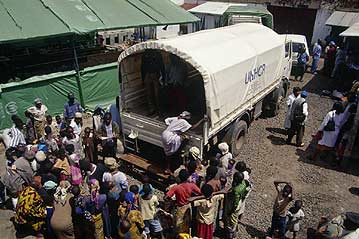Lesson plans for ages 12-14 in History: The Rwandan Crisis 1994
Teaching Tools, 4 March 2007

LESSONS 4 and 5: Going back home
Preparation
Run off copies of the three issues of Rwanda Returnee News.
Procedure
Divide the class into three groups.
Ask the students of the first group to read the first issue of Rwanda Returnee News and to summarise it into a short 15 minute presentation that they will give to the class. Their presentation should be based on answers to the following questions:
- How does the editor define society in post-genocide Rwanda?
- What are UNHCR and the Rwandan government committed to, regarding the return of refugees to their home country?
- With the help of the internet, find out what are 'gacaca' courts.
- What has happened to many Rwandans who were imprisoned on charges of genocide?
- Give reasons why many Rwandan refugees have decided to return to their home country.
- Describe the type of assistance that was provided by UNHCR to returnees to Rwanda.
Ask the students of the second group to read second issue of Rwanda Returnee News and to summarise it into a short 15 minute presentation that they will also give to the class. Their presentation is based on answers to the following questions:
- What caused the reluctance of Hutu refugees to return to Rwanda?
- How did the authorities in Rwanda diminish the incidences of revenge and retaliation against returning Hutu refugees?
- Describe the ethnic composition of the Rwandan government.
- The editor writes that 'an eye for an eye will soon leave everyone blind'. What is required of the Rwandans to ensure this situation does not come about?
- Describe how justice has been carried out in Rwanda.
- Ask the students of the third group to read the third issue of Rwanda Returnee News and a selection of the news stories, and to prepare their presentation based on the following questions.
- Describe the various worries and difficulties that face Rwandan refugees returning home.
- Many Rwandan refugees found life in refugee camps more attractive than returning home, despite evidence of safety and security in their own country. Why?
- Not all Rwandan refugees found shelter in refugee camps in neighbouring countries. Describe some of the places where they had been hiding for years. What caused their reluctance to return home?
- Describe how some Rwandan refugees have developed their livelihoods.
Ask the students of the third group to read the third issue of Rwanda Returnee News and a selection of the news stories, and to prepare their presentation based on the following questions.
- Many Rwandan refugees found life in refugee camps more attractive than returning home, despite evidence of safety and security in their own country. Why?
- Not all Rwandan refugees found shelter in refugee camps in neighbouring countries. Describe some of the places where they had been hiding for years. What caused their reluctance to return home?
- Describe the various worries and difficulties that face Rwandan refugees returning home.
- Describe how some Rwandan refugees have developed their livelihoods.



